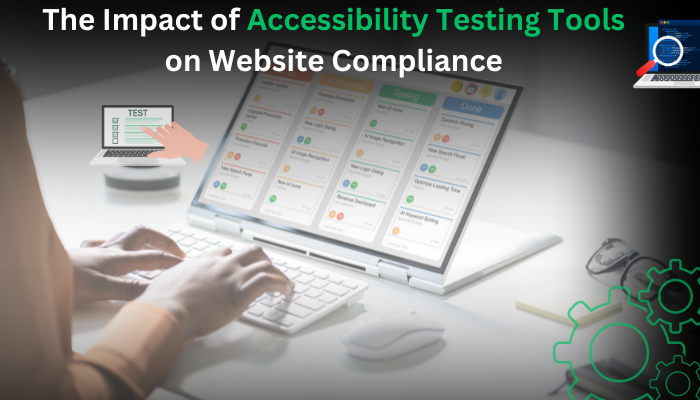Introduction
Ensuring digital accessibility is not just about compliance—it’s about inclusivity. Millions of users rely on accessible websites to navigate content effectively, yet many websites still fall short of meeting legal and ethical standards. This is where automated accessibility testing plays a transformative role.
By leveraging advanced accessibility testing tools, businesses can enhance user experience, maintain compliance with regulations like the Web Content Accessibility Guidelines (WCAG), and avoid potential legal repercussions.
In this article, we’ll explore how automated accessibility testing impacts website compliance, the best tools available, and why every organization should prioritize accessibility testing in their development process.
1. What Is Automated Accessibility Testing?
Automated accessibility testing refers to the process of using software tools to scan websites and identify accessibility issues. These tools analyze web pages against predefined guidelines and highlight elements that may create barriers for users with disabilities.
While manual testing remains essential for usability verification, accessibility testing tools help developers catch common violations quickly, making the compliance process more efficient.
Benefits of Automated Accessibility Testing
- Efficiency: Runs tests on multiple pages in minutes.
- Consistency: Ensures every page meets the same compliance standards.
- Cost-Effective: Reduces the need for extensive manual audits.
- Scalability: Works for small websites and large enterprise platforms alike.
2. The Role of Accessibility Testing Tools in Compliance
Compliance with accessibility standards like WCAG, Section 508, and the ADA (Americans with Disabilities Act) is essential for businesses and government entities. Failure to comply can lead to legal actions, financial penalties, and reputational damage. Accessibility testing tools play a critical role in helping organizations maintain compliance and provide an equitable user experience.
How These Tools Support Compliance
- Identifying WCAG Violations: Detects missing alt text, improper color contrast, and keyboard navigation issues.
- Generating Compliance Reports: Provides detailed reports outlining accessibility errors and solutions.
- Facilitating Remediation: Offers recommendations for fixing issues in alignment with legal standards.
3. Best Automated Accessibility Testing Tools for Website Compliance
Not all accessibility testing tools are created equal. Below are some of the top options that can streamline compliance efforts:
a. Axe Accessibility Testing Tool
One of the most widely used accessibility testing tools, Axe offers a robust browser extension that integrates seamlessly with development workflows. It identifies WCAG violations with clear explanations and solutions.
b. WAVE Web Accessibility Evaluation Tool
WAVE provides a visual representation of accessibility errors, helping developers and content creators understand problem areas. It is particularly useful for evaluating color contrast and structural issues.
c. Lighthouse (by Google)
Lighthouse is an open-source tool that runs accessibility audits alongside performance, SEO, and best practices analysis. It’s a great option for developers looking to improve web accessibility alongside other metrics.
d. Tenon
Tenon is a flexible tool that provides detailed reports and integrates with CI/CD pipelines for continuous accessibility testing.
e. Pa11y
Pa11y is an open-source tool that automates accessibility tests and generates reports, making it ideal for organizations looking to integrate automated accessibility testing into their development process.
4. Automated vs. Manual Accessibility Testing: Finding the Right Balance
While automated accessibility testing is invaluable for identifying common issues, it does not replace manual testing entirely. Some accessibility barriers, such as cognitive usability or screen reader experience, require human evaluation.
When to Use Automated Testing
- Checking for color contrast violations
- Validating HTML structure and ARIA attributes
- Identifying missing alt text
- Scanning large-scale websites quickly
When to Use Manual Testing
- Evaluating user experience with assistive technologies
- Testing keyboard navigation and interactive elements
- Assessing the usability of dynamic content
5. How Accessibility Testing Tools Enhance User Experience
Beyond compliance, accessibility testing tools contribute to a more user-friendly website. When websites are accessible, they cater to a broader audience, improving usability for people with disabilities and those using mobile devices or alternative input methods.
Key Enhancements to User Experience
- Keyboard-Friendly Navigation: Ensures all functions are accessible without a mouse.
- Improved Readability: Enforces clear typography and contrast ratios.
- Better SEO Performance: Accessible websites often rank higher in search engines.
- Inclusive Design: Makes content available to a wider range of users.
6. Steps to Implement Automated Accessibility Testing in Your Workflow
For organizations looking to integrate automated accessibility testing into their development process, the following steps can help streamline implementation:
Step 1: Choose the Right Accessibility Testing Tools
Select Accessibility Testing Tool that align with your platform and compliance needs. A combination of automated and manual tools often yields the best results.
Step 2: Integrate Testing into CI/CD Pipelines
Automating tests within your development workflow ensures accessibility remains a priority throughout the software lifecycle.
Step 3: Train Your Team
Educate developers, designers, and content creators about accessibility best practices to prevent issues from arising in the first place.
Step 4: Conduct Regular Audits
Accessibility is an ongoing process. Regularly testing and updating your website ensures long-term compliance.
Step 5: Gather User Feedback
Engaging with users who rely on assistive technologies provides invaluable insights for improving accessibility further.
Read This Article Also – How to Perform an Accessibility Audit with Accessibility Testing Tools
Final Thoughts
The impact of automated accessibility testing on website compliance cannot be overstated. By utilizing accessibility testing tools, organizations not only adhere to legal requirements but also foster inclusivity, enhance user experience, and improve overall web performance. While automation significantly reduces the workload, balancing it with manual testing ensures comprehensive accessibility coverage.
Investing in accessibility is not just a legal obligation—it’s a commitment to providing an equitable digital space for all users. By integrating automated accessibility testing into your development process, you can future-proof your website and create a more inclusive online experience.
To Read More Articles, Explore This Site – https://insidetechie.blog
 :
https://uk.pinterest.com/testevolve/
:
https://uk.pinterest.com/testevolve/












